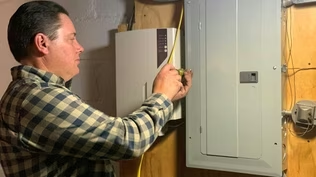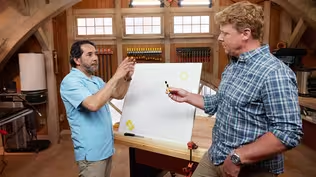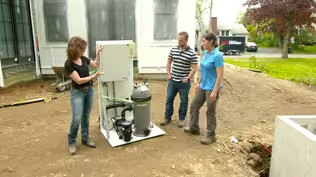
E11 | Lexington Modern | Electrical Bond
Season 45 Episode 11 | 23m 42sVideo has Closed Captions
Electrical work for the elevator begins and the therapy pool is installed.
The therapy pool is scheduled to be delivered onsite. To reduce the risk of shock, Heath Eastman installs bonding around the pool's perimeter. Inside, Interior designer Rachel Dunham talks tile selections with Kevin O'Connor. Tom and Charlie Silva recap the construction processes of the integrated ramp at the front entrance. Electrical work for the elevator begins. The therapy pool is craned in.
Problems playing video? | Closed Captioning Feedback
Problems playing video? | Closed Captioning Feedback
Funding for THIS OLD HOUSE is provided by The Home Depot and Renewal By Andersen.

E11 | Lexington Modern | Electrical Bond
Season 45 Episode 11 | 23m 42sVideo has Closed Captions
The therapy pool is scheduled to be delivered onsite. To reduce the risk of shock, Heath Eastman installs bonding around the pool's perimeter. Inside, Interior designer Rachel Dunham talks tile selections with Kevin O'Connor. Tom and Charlie Silva recap the construction processes of the integrated ramp at the front entrance. Electrical work for the elevator begins. The therapy pool is craned in.
Problems playing video? | Closed Captioning Feedback
How to Watch This Old House
This Old House is available to stream on pbs.org and the free PBS App, available on iPhone, Apple TV, Android TV, Android smartphones, Amazon Fire TV, Amazon Fire Tablet, Roku, Samsung Smart TV, and Vizio.

This Old House Insider Newsletter
Get This Old House exclusive stories, tips, and behind-the-scenes information delivered right to your inbox every month.Kevin: Today on "This Old House"... Tom: Work on the job site is ramping up.
Charlie: All right, let it go.
Kevin: We'll show you one of the ways that we're honoring this home's mid-century modern roots.
Charlie: Look up in the sky.
It's a bird.
It's a plane.
It's a 4,000-pound therapy pool.
♪♪ ♪♪ Man: Ahh.
That's it.
♪♪ ♪♪ ♪♪ Kevin: Hi, there.
I'm Kevin O'Connor, and welcome back to "This Old House" and to Lexington, Massachusetts, a town that is steeped in history.
This town is the birthplace of the Revolutionary War, and the first shots of that conflict were fired right there on the town common, also known as Battle Green.
Well, about 250 years later, Lexington is a very popular suburb, thanks in part to its proximity to Boston, just 10 miles from here, great schools, and a bustling downtown.
Lexington is home to about 35,000 diverse residents, and the town has to make sure that all of those residents have equal access to its public spaces.
The CDC estimates that about 12% of Americans have some sort of mobility issue.
And so in this town, you can find ADA-compliant things like ramps, automatic opening doors, accessible bathrooms, even accessible playgrounds, all throughout town.
And the need to have accessible public spaces -- well, that extends to the private houses as well.
And if you've been following along this season, you know that's why we're here in Lexington.
It is the home for our family -- a young family of five -- and their middle son has a rare disease called Duchenne muscular dystrophy.
And making the house accessible -- well, that's what's driving this entire renovation.
[ Hammer pounding ] It is a busy day here on the job site.
We've got most of the trades here trying to get this project wrapped up.
We're about two-thirds of the way done.
Out front, we've got a little bit of new space with that big, sloping roof line right there.
It creates a generous overhang over the front entryway, and it is woven nicely into the original part of the house, which is right here.
It's got that beautiful brick facade, a feature that you can enjoy from the outside as well as in.
And then out back, new space as well.
So on that addition, they've got that nickel gap siding along the side to match some of the details that are on the front of the house.
Grading is very important to us on this job site.
So from this retaining wall forward, all of this and out front is gonna be just one grade.
So the bluestone will go on the concrete, and then this right here will be filled in in one continuous grade all the way to the front door.
This will all be bluestone here on the back patio with a center drain.
And look at this, right across there -- perfectly smooth, no trip points.
And that bluestone level, well, that is gonna continue -- hey, Fred... Fred: Morning, Kevin.
Kevin: ...all the way into the house.
So finished floor and bluestone, one level for the entire first floor.
Basically, this entire area right here -- this is Caffrey's backyard, so he's gonna have access to it with no problem in using it.
And it's a big day today because our therapy pool should be here, going right in there.
Hey, Heath.
Heath: Hey, Kevin.
Kevin: So you've got one more thing to do before we get our pool in... Heath: Just one more.
Kevin: ...which I don't fully understand.
What is with the copper grid here?
Heath: Bonding.
Kevin: Meaning what?
Heath: A lot of rules come into play when we're dealing with a pool.
So the first thing we want to do is contact your local inspector and see what requirements they may or may not have in addition to the national code.
And this installation is a little bit special, a little different.
So we have what would normally be a freestanding tub.
If it were freestanding by itself, no problem.
We can treat it like a hot tub or a spa, standard connections for that.
In this case, it's sunk down a little bit.
And because we can actually reach in from the deck into the pool, he now wants to treat this as an in-ground swimming pool, and that's where this comes in.
Kevin: Wait, so what is bonding?
Heath: So bonding, simply, is connecting all the metal parts in a particular system.
Kevin: And what are the metal parts in the pool?
Are we talking about, like, the ladder and a drain or something like that?
Heath: Exactly.
So the socket where the lift goes into -- that's bonded.
The motor is gonna have a lug on it -- that's bonded.
Any metal parts that are within five feet of the pool want to be bonded.
And also, our code requires a three-foot area outside of the edge of the pool.
Kevin: Mm-hmm.
Heath: And that wraps the entire way around, goes over, comes down under the bluestone, picks up the rebar, picks up everything in here.
Kevin: And what does the bonding do for us?
Heath: The bonding creates what we call an equipotential plane.
Kevin: Easy for you to say.
Heath: And that makes everything equal.
That keeps us safe and prevents any voltage gradient, so no stray voltage can get in here and cause a difference in potential.
And I know that's a little complicated, but what it means is if we had something leaking voltage and, say, this patio was wet -- chance to get a couple of volts to it from a leaking line buried in the ground, and the pool didn't have that, you're in the pool water, you hit the patio or some other metal part that has a slight difference, that's where you risk getting shocked.
Kevin: So this copper grid connects the patio from three feet, potential lift coupling there, to the water, to the pool, to the motor, to the ladder.
It's all connected.
Heath: Keeps it nice and safe.
Kevin: Okay, well, I'll take your word for it.
I don't fully understand it, but the fact that you're working on it gives me a good peace of mind.
All right, thanks, Heath.
Oh, and we're not done with you.
I got to talk elevators with you a little later.
Heath: All right.
Sounds good.
Thanks.
Kevin: And speaking of elevators, you can see we've got our elevator shaft right here, or hoistway, as they call it.
It is framed.
It has got the board up, plaster to come soon, and it rises from the ground level down there right up here to the first floor and just steps from Caffrey's bedroom that also has an adjoining bathroom.
Hey, Rachel.
Rachel: Hey.
Nice to see you.
Kevin: Yeah, I know you've been working hard with Billy and Michelle on the design of the house, so thank you for that.
Rachel: You're welcome.
Kevin: And here in Caffrey's bathroom, two marching orders that I know of, at least, which was keep it mid-century modern, and then obviously accessibility for Caffrey.
Rachel: Yes.
Kevin: So how'd you pull that off for us?
Rachel: Yeah, so the tile in the house, you'll see a lot of the selections are mid-century in the style and just the layout of how we laid out the tile on the walls and the floor.
Kevin: Okay.
Rachel: In Caffrey's bath, we wanted to keep it a little more masculine with a black-and-white look... Kevin: Right.
Rachel: ...and also wanted to make sure that it would be safe for Caffrey as he grows into the room, so we chose a mosaic tile.
It's a 1x4, meant to look like a Belgian bluestone, which is a natural stone.
Kevin: Okay.
Rachel: But lots of grout lines, so a lot of gripability for him or his caregiver as they're moving through the room.
Kevin: So a couple questions, like, what about this is mid-century modern -- the shape, or the fact that you guys either put it vertically or down here on the floor?
Rachel: Yeah.
Kevin: Like, what makes it mid-century modern to your eye?
Rachel: You know, the shape of it, the way that it's a straight stack, so instead of having something that's offset, which is a little more traditional-looking, that's one.
Also just, it's a porcelain tile, but it's meant to look like a Belgian bluestone, which is a natural stone, and there's a lot of natural materials in mid-century modern homes.
Kevin: Right.
And then your other point about gripability -- the more joints we have, you're saying the more grout we have, so it gives a texture as opposed to big tiles, which can be more slick.
Rachel: Exactly.
Kevin: And what's the idea with having the floor kind of come straight through and then up a single accent wall in the middle?
Rachel: Sure.
Yeah, so we're gonna run the floor up the wall.
It'll act kind of like one big stripe through the room and just be a decorative element.
I think if we had done black everywhere, it would have just felt very dark in here.
Kevin: Yeah, sure.
Rachel: And the black plumbing fixtures will pop against the white walls, too... Kevin: I'm just gonna reach over here.
If you'd hold that for a second.
Rachel: Sure.
Kevin: So this is your wall tile, at least on two walls.
And that I get with the mid-century modern, right?
And so you put it kind of in the vertical position right there.
You take the subway tile, you elongate it, you make it narrow.
That gives a modern feel to it.
And what is this, matte?
Rachel: Yeah.
So that's a matte finish.
Kevin: All right.
Well, the waterproofing literally just went in not that long ago, so the tiler is making great progress right here.
You're also helping us make progress with tile in the laundry room, right?
Rachel: Exactly.
Kevin: Can we look at that?
Rachel: Yeah, definitely.
Kevin: We got work going on in every room.
Oh, in here, too.
Hey, Sandro.
Sandro: Hey.
Kevin: Making some good progress in there.
[ Laughs ] What have you chosen for tile?
That is bold.
Rachel: Yeah, it's a pretty wild choice.
So, in the original house, there was this flooring called terrazzo, which is like a cement-like tile.
It has chunks of stone in it.
And it was an avocado green.
Kevin: Yeah.
Rachel: But unfortunately, when the house was demoed, we had to take it out.
So we wanted to pay tribute to that somewhere in the house, so I selected this green terrazzo-like tile to go into the laundry room.
Kevin: I see the green embedded in there.
I get that, although it is a -- it's a busy tile.
There's a lot going on, not just the green, but some darks, some lights, some pinks here.
Rachel: Yep.
So we actually decided to do the upper cabinets in this pink color, but everything else in here will be neutral.
Kevin: I gotcha.
Okay.
Well, if it's sort of a tribute to the original, I like it and I get it.
We do have to think about accessibility, so I presume this just comes right out to our finished flooring as well, no thresholds?
Rachel: Yeah.
So, normally this type of flooring that looks like a terrazzo is really thick, but this one is only 3/8 inches thick.
So it will provide a seamless entry for Caffrey to use the room.
Kevin: That's good to know.
Rachel: Yeah.
Kevin: And then more tile, also, on a very mid-century modern fireplace, right?
Rachel: Yes.
Exactly.
Kevin: Show me that, please.
Rachel: Okay.
Kevin: Hey, Michelle.
Michelle: Hey.
How are you?
Kevin: I love your laundry room tile.
Michelle: Oh, I know you do.
[ Laughter ] It's fun, isn't it?
Kevin: It's avocado green.
You win.
Michelle: Yeah.
It's fun.
Kevin: All right, so this is a big fireplace, or going to be.
Michelle: Yeah, it will be.
Kevin: What is this gonna look like?
Michelle: So we've already picked out the fireplace, which Charlie has obviously started to frame out.
So it's gonna be a gas-insert fireplace.
It'll have natural-looking logs throughout the firebox.
Kevin: Gotcha.
So sealed unit, real flame, exhaust to the outside.
Michelle: That's right.
Kevin: Awesome.
And so you've got to decide how to trim it out, obviously.
Michelle: That's right.
Kevin: What do you guys think?
Like, what are you going for?
Rachel: Yeah.
So we picked a few different tiles here that have kind of a brick look, because there's a lot of original brick walls in the house.
And there was one in here, as well, in the living room.
Kevin: You had always told us you loved the original brick.
And Mark McCullough has told us it's really rare.
You can't get it anymore.
But that's a distinctive look.
Rachel: That's right.
Kevin: So you're playing off of this, or trying to.
Michelle: Yeah.
I mean, we're trying to bring in, you know, the feel of brick back to the room, although despite the fact that we weren't able to keep it.
Kevin: So a very distinctive style, long and narrow.
It's got that sort of hand-forged look.
Michelle: Yeah.
What we're really trying to do is also play off of some of the other materials that we're putting into this room.
So this here is a piece of stone that will be over at the wet bar.
Lots of color and dimension here, so it's gonna be a nice, dramatic piece in the room.
Kevin: I love these because this is actually like a sliced brick, so brick veneer, and then it's just got a sort of a gray glaze to it.
Michelle: Yeah, I think these are really beautiful, too.
But when I put them here up in this room and also against this stone, you know, the question I have here is, is it a little bit too rustic?
You know, I think it might not be the true sort of, like, mid-century modern vibe that we're aiming for.
Kevin: You're letting me down easy.
You're not going with my choice.
It's your house.
Michelle: I love your style, Kevin.
Kevin: It's your house.
Michelle: But, yeah, maybe not today.
Kevin: All right.
What did you think of this?
Michelle: So I really like the shape of this one, too.
And the size is actually quite large, but I think it's gonna be a bit dark, right?
So this is gonna be a big wall here, a big firebox here, and I think that might just be a little bit too black.
Yeah, I mean, I think these are also really, really good options.
I mean, I love the sort of striations here on this tile.
And truth be told, I actually really like this tile so much that Rachel and I have already selected to use this in part of the kitchen, so...
But maybe it would be nice here, too.
But maybe we'll let the kitchen have this moment with this tile.
Kevin: So by process of elimination, is this your choice?
Michelle: I actually really like this one.
And what I love about this is, you know, it's got this very interesting texture here, which I think will be nice with the various different textures that we're putting in this room.
It also has, like, a little bit of this curve line to it.
Kevin: It's hard to see, but as soon as I pick it up, I feel it.
Michelle: Yeah, you feel it.
Kevin: And I bet you when it's an entire wall of it, you will get that.
Will you run it horizontally?
Will you run it vertically?
Do you know?
Rachel: I think we're gonna do it vertically, switch it up.
Michelle: Straight stack, too?
Mid-century modern style?
Rachel: Exactly, yeah.
Kevin: Straight stack.
Look at you.
[ Laughs ] You got all the terms.
Michelle: I've learned a lot on this project.
Kevin: Hey, listen, It happens.
So is this the final choice?
Michelle: Yeah, I think so.
I think it's gonna look really great, also, with this, so I think it'll all come together really nicely.
Kevin: Awesome.
And you know, it doesn't matter what I think.
So long as you guys are making choices and you're happy, that's what's most important.
All right.
Thank you, Michelle.
Thank you, Rachel.
Rachel: Yeah.
You're welcome.
Kevin: Awesome.
Great working with you.
Michelle: Thanks, Kevin.
♪♪ ♪♪ Tom: It's nice to see this front walk and this ramp come into play for Caffrey.
It's gonna really help him get in and out of the house.
We've also made sure that all of the doorways leading outside are all at the same elevation, all the way around, no steps up or down.
Charlie: That's right.
Tom: But a lot of work goes into making this ramp.
Charlie: That's right.
And it started with a trench, so we had to excavate a trench from the other corner of the garage where service comes in.
We put a base layer of sand in and then put 12 different pieces of PVC.
And once those were installed and corded through the house, and those holes were waterproof, another layer of sand.
And on top of that, we did about a seven-inch pour of concrete.
That's a structural slab with rebar that is drilled into the foundation.
Tom: Right.
And that's really strong.
On top of that, we have the insulation, and you can see all the tubing that's gonna have the radiant heat in it.
And that's all glycol, so it's protected against the freeze.
Charlie: That's right.
We have a sensor in the pour, so it'll sense temperature as well as moisture.
Tom: Yeah, a lot of people think you run radiant heat outside, you gotta run that all the time.
It will never come on in the winter if it's not cold enough or if it doesn't snow or rain on it.
Charlie: That's right.
It's gonna be a great system.
Tom: Absolutely.
All right.
Well, looks like they're getting ready to pour that top layer.
Charlie: All right, let it go.
♪♪ Tom: This mix is the 4,000 mix.
That's the [indistinct], or the weight.
It has peastone in it, a fiber in it, and they also inject air in it.
♪♪ ♪♪ Charlie: This top section of the ramp is actually level in front of the two side lights and the front door, and our pitch starts right about here and is about 20 feet long.
Tom: Right.
And we have a line right here to follow all the way down to continue that pitch.
♪♪ ♪♪ Gonna hit this with the vibrator real quick.
It's gonna be about probably 2,000 or 3,000 revolutions a minute, and it vibrates and actually moves the concrete around, and it just levels itself right out.
You don't want to do too much, because you don't want it to become soupy and run down the hill.
Once he gets it roughly where he wants, he's gonna take a streak and run across from the two flat spots on each side, go back and forth, and work it down.
Charlie: So we have two levels of concrete that we're pouring.
Where I'm standing is where the asphalt's gonna go in the driveway.
The bluestone will stop at this edge, which the concrete pour will be here, then the bluestone on top.
Our concrete level will be poured at this line, then our asphalt will make up the difference to match the bluestone.
Tom: Now, if you notice, this concrete is a lot more loose than the other because it can flow better, it can pull better, but it also will stay level.
We wouldn't want it this loose on the ramp because all of it would end up down at the bottom.
♪♪ All right, so Kevin's flattening the surface with a bull float.
And that's basically taking the imperfections out.
Then later, once it sets up a little more, he'll broom it to give it a little bit of texture.
That's because there's a bluestone going over here, and that'll give him great adhesion.
And that bluestone will bring the height right up to the door where it needs to be.
Charlie: That's right.
And any time you're building a ramp at a residence, it's always nice to follow ADA guidelines, even though you don't have to.
In this case, we were going from finished floor to garage floor where pavement with a driveway, and we had a difference of 13 3/4, and our ramp is about 20 feet long at the pitch.
Tom: Yeah, well, ADA compliance is I made a little wedge right here.
It's 12 inches to 1 inch, so every 12 inch you go up 1 inch.
But I drew a line on this side where our pitch is.
So we're actually lower than ADA compliance, so it's even better.
Charlie: It's gonna be real nice.
Tom: Yeah.
Kevin: Down here on the lower level, we are wrapping up rough electrical, waiting on insulation.
And this is where our elevator hoistway terminates.
Now, per Massachusetts code, we need a separate mechanical room within 10 feet of this space right here, a place to put the hydraulics, the mechanical equipment, and the electrical equipment -- Hey, Heath... Heath: Hey, Kevin.
Kevin: ...which looks like most of it is already in?
Heath: Yeah, our end of this is really pretty simple.
The elevator company gives us a checklist to follow, and there's not a whole lot on here for us.
Kevin: All right, what is on there?
Heath: So the first thing is they want two disconnects, two heavy-duty disconnects that come in.
One's gonna be for the lights, and one's gonna be for the actual elevator equipment and control.
Kevin: So shut the whole system down, elevator-specific, if you have to.
Heath: Exactly.
And they want those located within the door within 18 inches so they can just open the door, reach in, be familiar where they're gonna be consistently, shut them down, and then come into service if they had to.
Kevin: Because the elevator company is really gonna send the service people out here.
Heath: Exactly.
It's not gonna be us.
It's gonna be them.
Kevin: What does heavy-duty mean?
Heath: So the reason they want heavy-duty is, you can see, when this door is open, that you can't turn this on.
So there's no chance of energizing this.
When you're trying to work on this, keeps it safe.
And the same case, when you go up top when the door is shut and you turn it on, the door can't open.
Kevin: Oh.
No prying hand.
Heath: No prying hands.
Kevin: Gotcha.
And then in terms of amount of power, what have they asked for?
Heath: So they asked for a 15-amp circuit for the lights and a two-pole 30 circuit, two 40 volts, to this for the controls.
And then they want fuses so they can fuse it if they want to drop the fuse size, if the controls are a little different.
So this will be the max that they'd ever use, and they can always reduce it.
Kevin: Okay.
Well, it looks like you're almost done.
I appreciate it.
And the pool's coming soon, so you're a busy guy today.
Heath: Sounds good.
I'll wrap this up.
Kevin: Thank you, Heath.
♪♪ So the therapy pool has been trucked in.
This is it right here -- about 7 1/2 feet wide, 20 feet long, and I'm told over 4,000 pounds empty.
So that's a big piece of equipment to move.
We've got a crane coming in right here.
And in addition to having to lift that, it's also got to be about 80 or 90 feet away.
So we need a big boom because it's going right down here in this spot.
Charlie, Tommy, a lot of industry here this morning with this stuff.
I'll be honest.
This is my first therapy pool.
What is it?
I mean, is it a big hot tub or something?
Like, what...?
Charlie: Well, there's a hot tub in one section of it.
Kevin: Yep.
Charlie: And then the other section is gonna be like a swim spa.
But this is something that the entire family is gonna be able to use and be together 12 months of the year, believe it or not.
Kevin: Okay.
And then the therapy part works how?
Charlie: Well, the buoyancy of the water is gonna help Caffrey with his muscles, so it's much easier in the water for movement than it is out of the pool.
Kevin: Gotcha.
Tom: It keeps him light so he can float.
He can do his exercise.
There's no really direct pressure or force on your joints.
Kevin: So it's gonna look beautiful.
But quite a bit of work goes into the prep for the site, too.
Charlie: Oh, yeah, months ago, we had to put in new retaining walls with big footings.
And underneath our feet below the bluestone is a 12-inch structural pour that's tied into the foundations.
Tom: Yeah, I mean, the pool is 4,000 pounds, but then you gotta add the weight of the water, which is probably another 16,000 on top of that.
So there's 20,000 pounds of weight pushing down on this constantly.
Kevin: Okay.
Tom: And so you've got to make sure that nothing moves over time.
Charlie: And we also put a drainage system in along the sides, so any water that gets below here will drain right into our systems that all of our drainage goes into.
Tom: Yeah, it's like belt and suspenders.
I mean, this is basically just level, so the water will kind of sit, but it will also have someplace to go.
It won't build up.
Kevin: All right.
Wee ready to rig it up and start swinging it into place?
Charlie: We're ready.
Tom: We're ready.
Kevin: Let's get this thing in.
Man: Cable up a little bit, just till we get it tight.
♪♪ Tom: Gotta push that end back.
Charlie: We got to go in about 22 feet to you guys to the house.
Right.
Bring it down a little.
We got it.
♪♪ Another six inches to the house.
All right.
That looks good right there.
♪♪ ♪♪ Kevin: So, Charlie, a lot of times pools have to be protected -- fence around the yard or around the pool itself.
Is that the story here?
Charlie: Not in this case, because this pool cover has a lock, so we don't need a fence.
Kevin: Good deal.
All right, well, a lot of industry and progress today.
What have we got coming up next?
Charlie: Elevators going in.
Kevin: Elevator.
I love it.
Tommy?
Tom: White oak floor in the entire house, getting ready to start.
Kevin: Very nice.
And I hear the kitchen cabinets may be going down, assuming that white oak floor goes in.
So until then, I'm Kevin O'Connor.
Tom: I'm Tom Silva.
Charlie: And I'm Charlie Silva.
Kevin: "This Old House" here in Lexington, Massachusetts.
Charlie: Check it out.
Kevin: I've never seen anything like it.
Tom: Looks good, doesn't it?
Kevin: Yeah.
Kevin: Next time on "This Old House"...
It's time to take this renovation to the next level with the installation of a residential elevator.
Tom: I'm using these leftover floorboards to put some modern detail on the back of the kitchen island.
Kevin: Well, that's a great look.
Charlie: And here comes the sun and the solar panels.
Believe it or not, the engineer said, this is about an eight-year payback.
And in my book, that's pretty good.
♪♪


- Home and How To

Hit the road in a classic car for a tour through Great Britain with two antiques experts.












Support for PBS provided by:
Funding for THIS OLD HOUSE is provided by The Home Depot and Renewal By Andersen.






